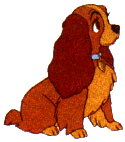Checkmate's CockerCondo:
a rescued cocker spaniel




New Baby In The House 
One of the situations that we hear frequently about from pet owners has to do with new babies, toddlers, and their dogs. Unfortunately, many times we are hearing about this after problems have already developed and the owner is considering surrendering their dog. The most important thing that any pet owner should know about bringing a baby into a household with a dog is to prepare ahead of time. Knowing how to handle the time before the baby comes home and the first few days of the baby's homecoming will allow everything to go much more smoothly.
There are a couple of things to do before the baby arrives. First, try to get a tape of a baby crying that you can begin playing in your house for increasing lengths of time. This will help the dog to get used to this strange sound. Another suggestion is to have your dog spend time with friends and family who have a baby to allow him to get used to the smells and sounds of a baby. Once the baby is born, but before she comes home, bring an article of the baby's clothing or a baby blanket home so the dog can get used to the smells of the baby.
Most importantly, make any changes, whether it is a change in where he sleeps or when he exercises, to the dog's routine before the baby comes home, so that the dog will not associate the changes with the baby. The dog should remain a part of the family and should not be relegated to the outdoors or the basement, even if only temporarily.
There are several tips to consider once you are ready to bang the baby home. This is a very important time for your whole family, including your dog.
- Bring the baby home in a carrier and allow the dog to sit near the carrier. Give the dog some treats so that he associates the baby favorably and thinks that good things happen around the baby.
- Allow the dog to sniff the baby. Pet him and give him praise while he sniffs.
- When you pick up the baby, continue to give the dog treats and praise.
- Only pet the dog in the baby's presence for the first few days. Remember to give the dog plenty of attention when the baby is around. It is often tempting to give the dog lots of attention when the baby isn't around because that's when you will have more time, but the dog will quickly figure out that good things happen when the baby isn't around.
- Feed the dog in the baby's presence. Again, the idea is that all good things happen around the baby.
- When it is time to let the dog outside, put him outside before your pick up the baby.
- Don't scold the dog for picking up the baby's toys. You don't want the smell of the baby being associated negatively to the dog. Simply give the dog its own toy and wash the baby's toy.
Many of these suggestions may be near to impossible if you have a dog you can't control. If this is the case, then it is crucial that you get your dog obedience training before the baby arrives. Even a well-intentioned dog can be harmful to a baby if he isn't controllable.
Once the baby is old enough to begin crawling, watch carefully that she doesn't pull on the dog's tail, ears, etc. Even the most tolerant dog will have limits and may snap at the child. Snapping and growling are natural behaviors for dogs when they are trying to communicate a warning. As children get older, about four or five years old, they can be taught how to handle a dog correctly and even may begin participating in the care of the dog.
Additional safety tips for children and pets include:
Teach the children:
- NOT to reach for a dog's head the first time they meet a dog or excessively rough house around their own dog's head and face.
- NOT to look a dog straight in the eyes, which could be seen as a threat or a challenge by the dog.
- NOT to run up frantically to a dog, who may react fearfully and defend himself or jump and bite at the child's face.
- NOT to scream loudly at a dog, which could stress a dog or startle him, causing an aggressive response.
- NOT to bother the dog while he is eating or chewing on a chew toy, which could trigger an aggressive guarding response.
- NOT to hit, kick, slap, ride, or tease the dog in any manner.
But do teach the child:
- TO positively interact and pet the dog under direct supervision.
- TO be a junior dog trainer, and get the dog to sit with a treat, under parental supervision.
Finally, NEVER leave your dog and your baby or small child alone together. A child should be about 7 or 8 years old before they can be reliably trusted to handle the dog properly. A great book on this subject is Childproofing Your Dog by Brian Kilcommons.
Animal Talk, The Maryland SPCA, Winter 1999 Vol./. 9 No. 4
This page last updated 5/5/00 Get
your own FREE Website at
Get
your own FREE Website at 




